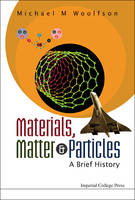
Materials, Matter And Particles: A Brief History
Seiten
2009
Imperial College Press (Verlag)
978-1-84816-460-4 (ISBN)
Imperial College Press (Verlag)
978-1-84816-460-4 (ISBN)
Starting with the ideas of ancient civilizations that air, earth, fire and water were the basic ingredients of all matter, this title traces the development of the science of chemistry beginning within the ranks of the alchemists.
This book traces the history of ideas about the nature of matter and also the way that mankind has used material resources that the world offers. Starting with the ideas of ancient civilizations that air, earth, fire and water were the basic ingredients of all matter, it traces the development of the science of chemistry beginning within the ranks of the alchemists. First, the idea of elements grew and then the atomic nature of matter was verified. Physicists had entered the scene, showing the nature of atoms in terms of fundamental particles and then introducing the concept of wave-particle duality that altered the basic concepts of what matter was. Finally the physicists discovered a panoply of fundamental particles, some observed within atom-smashing machines and the existence of others merely postulated.In parallel with the above there is a description of various kinds of matter as it affects everyday life — including the nature of matter associated with life itself. The way that early man used the materials directly given by nature, such as stone, wood and animal skins, is followed by the use of materials requiring some process to be employed — e.g. metals which include bronze and also concrete. Some important modern materials are discussed, such as synthetic fibres and plastics and semiconductors, and potentially important future products from new developments in nanotechnology.
This book traces the history of ideas about the nature of matter and also the way that mankind has used material resources that the world offers. Starting with the ideas of ancient civilizations that air, earth, fire and water were the basic ingredients of all matter, it traces the development of the science of chemistry beginning within the ranks of the alchemists. First, the idea of elements grew and then the atomic nature of matter was verified. Physicists had entered the scene, showing the nature of atoms in terms of fundamental particles and then introducing the concept of wave-particle duality that altered the basic concepts of what matter was. Finally the physicists discovered a panoply of fundamental particles, some observed within atom-smashing machines and the existence of others merely postulated.In parallel with the above there is a description of various kinds of matter as it affects everyday life — including the nature of matter associated with life itself. The way that early man used the materials directly given by nature, such as stone, wood and animal skins, is followed by the use of materials requiring some process to be employed — e.g. metals which include bronze and also concrete. Some important modern materials are discussed, such as synthetic fibres and plastics and semiconductors, and potentially important future products from new developments in nanotechnology.
The Elements of Nature; Early Ideas of the Nature of Matter; The Quest for Gold and Eternal Life; The Beginning of Chemistry; Modern Chemistry is Born; Nineteenth Century Chemistry; Atoms Have Structure; Radioactivity and the Nuclear Atom; Some Early 20th Century Physics; What is a Nucleus Made of?; Electrons in Atoms; The New Mechanics; Electrons and Chemistry; Electron Spin and the Exclusion Principle; Isotopes; The Processes of Radioactivity and More Particles; Making Atoms, Explosions and Power; Observing Matter on a Small Scale; Living Matter; Life at the Atomic Level; Materials from Ancient Tmes; Some Modern Materials; The Fantasy World of Particles; How Matter Began; Making Heavier Elements.
| Verlagsort | London |
|---|---|
| Sprache | englisch |
| Themenwelt | Sachbuch/Ratgeber ► Natur / Technik |
| Naturwissenschaften ► Chemie ► Physikalische Chemie | |
| Naturwissenschaften ► Physik / Astronomie ► Thermodynamik | |
| Technik ► Maschinenbau | |
| ISBN-10 | 1-84816-460-2 / 1848164602 |
| ISBN-13 | 978-1-84816-460-4 / 9781848164604 |
| Zustand | Neuware |
| Haben Sie eine Frage zum Produkt? |
Mehr entdecken
aus dem Bereich
aus dem Bereich
Quantenmechanik | Spektroskopie | Statistische Thermodynamik
Buch | Softcover (2024)
De Gruyter (Verlag)
59,95 €
Set aus Lehrbuch und Arbeitsbuch
Buch | Hardcover (2022)
Wiley-VCH (Verlag)
109,00 €
Thermodynamik | Kinetik | Elektrochemie
Buch | Softcover (2024)
De Gruyter (Verlag)
59,95 €


